- In 1970, the Russians started drilling Kola SG-3, an
exploration well which finally reached a staggering world record depth
of 40,230 feet. Since then, Russian oil majors including Yukos have quietly
drilled more than 310 successful super-deep oil wells, and put them into
production. Last Year Russia overtook Saudi Arabia as the world's biggest
single oil producer, and is now set to completely dominate global oil
production and sales for the next century.
-
-
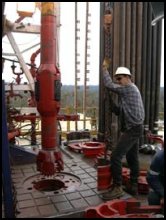 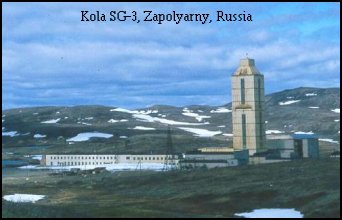 
-
-
- If the opening paragraph of this report started by claiming
that completely unlimited crude oil reserves exist inside planet earth,
readers might be tempted to regard the entire text as preposterous ghostwriting
for a novelist like Frederick Forsyth. If the report then went on to
claim that the Russians have exploited this stunning reality for nearly
thirty years, right under the largely unwitting noses of western intelligence,
readers could be excused for mistaking the author for a lunatic, or perhaps
as a front for spy novelist John le Carré. The problem here is
that unlimited oil reserves do exist inside planet earth, and the Russians
long ago developed the advanced technology necessary to recover these
unlimited oil reserves in an efficient and timely manner.
-
- Profoundly disturbing hard intelligence like this does
not sit well with the frantic cries of western academic shills and lobbyists,
determined to convince you all that the end of the oil world is nigh,
or, more accurately, that America faces an imminent catastrophe when global
production capacity "Peaks", i.e. when world demand for crude
oil finally exceeds the rate at which we can physically pump the required
product out of the ground. The gist of these false claims are outlined
in a speech given at the at the University of Clausthal, by lobbyist Doctor
Colin Campbell during December 2000:
-
- "In summary, these are the main points that we have
to grasp: Conventional [Free flowing] oil provides most of the oil produced
today, and is responsible for about 95% of all oil that has been produced
so far. It will continue to dominate supply for a long time to come. It
is what matters most. Its discovery peaked in the 1960s. We now find one
barrel for every four we consume. Middle East share of production is set
to rise. The rest of the world peaked in 1997, and is therefore in terminal
decline. World peak comes within about five years" [circa 12/2005]
-
- Campbell is just the tip of a giant iceberg of academic
Peak Oil 'experts' who suddenly appeared en-masse to give you this frightening
news, right after President Saddam Hussein suddenly started trading his
oil in Euros rather than in US Dollars, a devastating switch with the
easy capacity to destroy the US Dollar in less than five years if it was
left unchallenged and unchecked.
-
- So these shills [decoys] were carefully positioned to
deflect your attention away from the obvious greed and incompetence
of the United States Government and its Wall Street masters, and focus
it elsewhere instead. Then, hopefully, a few years later down the track
when prices start to bounce through the roof, and America has no Euros
to buy crude oil, you will blame gasoline prices of $5.00 + per gallon
at the pumps on an 'inevitable decline' in world oil production, rather
than march furiously on Washington DC with locked and loaded firearms.
-
- Though attacking Campbell and his ilk is not the purpose
of this report, his idiot claims can be debunked readily enough. While
it is true that nowadays we only officially find one barrel of oil for
every four barrels we consume, this is primarily because we temporarily
stopped the incredibly expensive process of looking for crude oil when
we had already physically established more than two trillion barrels of
reserves in known reservoir locations around the world. When those known
reserves drop to [say] one trillion barrels we may be tempted to go and
find more, but not until then. And while it is true that the production
rate from each individual oil well ever drilled has slowly declined over
the years, there is a perfectly valid technical reason for this predictable
reduced flow rate, which will be explained later.
-
- In order to understand how Russia has left the rest of
the world standing in its wake, it is essential to know a little bit
about where oil is located, and how it is extracted from the ground for
refining and commercial use. It is an enormously complex subject, especially
when considering the ultra-deep wells, which should really have a separate
category all of their own. Many years ago I was personally involved at
the sharp end of two ultra-deep drilling operations [one of them in direct
liaison with Russian experts from the Moscow Drilling Institute], and
will try to keep this drilling lesson as simple as I can. Thankfully perhaps,
the underlying principle of how and where oil is recovered from is not
difficult to comprehend, as illustrated by the diagram below.
-
-
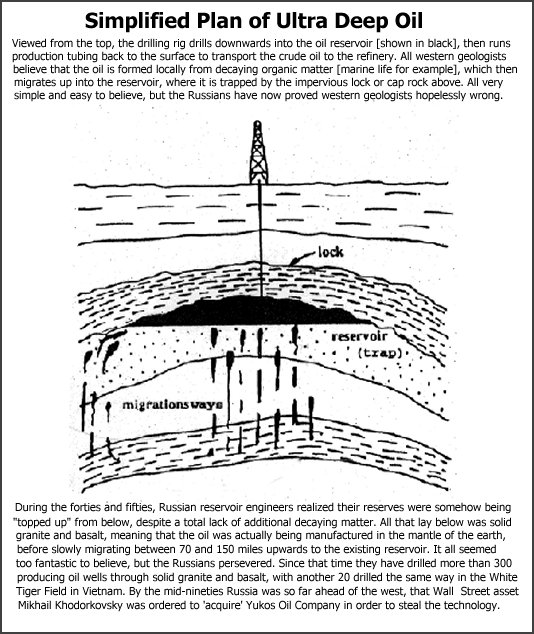
-
-
- The theory underlying how oil is formed at such enormous
depths in the mantle of the earth is not central to this report, because
the Russians have already proved its point of origin in absolute drilling
terms more than 300 times. Those interested in the exact process should
research the archives, where there are more than two hundred Russian papers
on the subject. Probably a good place to start would be "The Role
of Methane in the Formation of Mineral Fuels", written by by A.D.
Bondar in 1967. What is central to this report is the massive advantage
that Russia's ultra-deep drilling discoveries and technical achievements
give it over the western nations.
-
- The first advantage I intend to explain is nowhere near
as important in global terms as the second, because it is the second
advantage that finally drove the Zionist Cabal to illegally invade sovereign
Iraq, and thereby bring us all to the very brink of thermonuclear war.
However, from where I sit, the first advantage is much more important
in simple humanitarian terms, although "humanitarian" is not
an acceptable trading process on Wall Street.
-
- As we have already discovered, oil can be produced virtually
anywhere on earth, provided the host country can afford the expensive
[and sometimes classified] technology, and the massive cost of drilling
a well to extreme depth through extremely hard rock formations. But just
think what even 20 or 30 deep producing oil wells can mean for the people
of a country that has no natural resources of its own, or worse still,
for people who have been told by glib western lobbyists that they have
no natural resources of their own. Anyone who can prove that the western
nations were lying or simply wrong, will become a trusted friend forever.
Vietnam is a classic example.
-
- After more than 60 years of being enslaved, pillaged,
and raped by the French and then by the Americans, the poor Vietnamese
were told officially by American oil multinationals that their country
was barren; that western 'cutting edge' technology had failed to find
anything to help them recover financially from the mess left behind by
American bombs, Agent Orange, and a host of other delightful gifts from
Uncle Sam. This of course was exactly where America wanted the Vietnamese
to be: desperately poor and unable to take action against their former
invaders.
-
- The Russians had other ideas and a very different approach.
After telling the Vietnamese that the Americans had lied to them, oil
experts were flown in from Moscow to prove this startling claim in a no-risk
joint venture, meaning the Russians would provide all of the equipment
and expertise free of charge, and only then take a percentage of the profits
if oil was actually found and put into production. Vietnam had absolutely
nothing to lose, and swiftly gave Russia the green light.
-
- The Vietnamese White Tiger oil field was and is a raging
success, currently producing high quality crude oil from basalt rock
more than 17,000 feet below the surface of the earth, at 6,000 barrels
per day per well. Through White Tiger, the Russians have assisted the
Vietnamese to regain part of their self respect, while at the same time
making them far less dependent on brutal western nations for food-aid
handouts.
-
- All of a sudden in a very small way, Vietnam has joined
the exclusive club of oil producing nations, and a stream of cynical
U.S. Senators and Congressmen have started making the long pilgrimage
to Ho Chi Minh City in order to 'mend fences'.
- Predictably perhaps, the Vietnamese are very cool, and
try hard to ignore their new American admirers.
-
- Welcome to the White Tiger oil field in Vietnam. Observe
the truly amazing oil
- flares, in an area the Americans officially declared
'barren' of oil reserves !
-
-
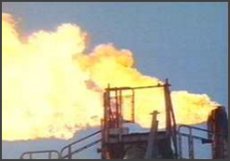 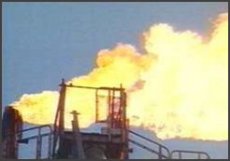 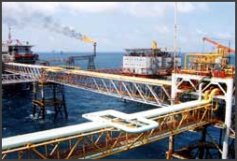
-
-
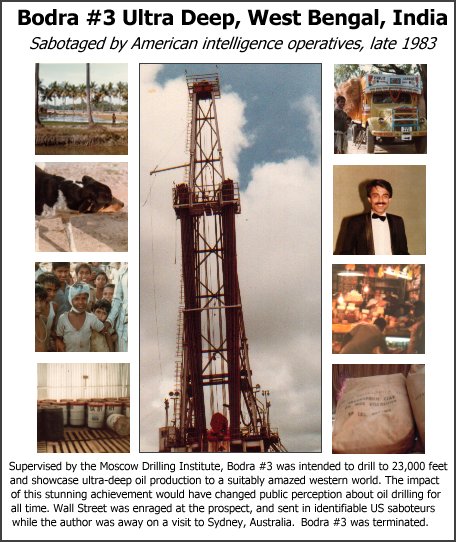
-
-
- It is truly amazing how quickly good news travels [outside
of CNN], and in a very short space of time China was also engaged in a
joint super deep venture with Russia. Nor did it end there. As I write
this report, intelligence reports that the Russians have already moved
three deep-drilling rigs into impoverished North Korea, where they intend
to repeat the Vietnamese production cycle by drilling thought solid granite
and basalt, with not a single trace of the 'decaying marine life' so essential
to blinkered western geologists for the 'accepted' production of crude
oil. It may take a while, but ultimately the North Koreans will be able
to go about their sovereign business without the Zionist Cabal in New
York being able to blackmail them over a few ship loads of food-aid rice.
Yes indeed, Korea will eventually have an oil surplus of its own, allowing
it to tell the latest in a long line of terminally insane "New World
Orders" to go to hell.
-
- The White Tiger project was the first outside Russia
to openly exploit and showcase this ultra-deep technology and oil production
from basalt rock to the world, though the original intent was to do so
much earlier in India during 1983. During that year a large drilling rig
in the Ganges Delta was scheduled to drill down to below 22,000 feet into
basalt, and then dramatically flare "impossible" ultra deep
oil. Oil well Bodra #3 was directly supervised by teams of experienced
Russian drillers and scientists from the Moscow Institute of Drilling,
with the author the only westerner on site, contracted to control one
of the critical advanced systems needed to reach target depth smoothly
and efficiently.
-
- If Bodra #3 had been allowed to drill ahead unhindered,
there is no doubt the resulting impact would have sent shock waves around
the oil world, and gained enormous international prestige for the Russians.
Even more importantly perhaps, the desperately poor people of West Bengal
would have gained access to their own energy reserves. Unfortunately,
Bodra #3 was not allowed to drill ahead unhindered. The Americans were
determined to stop the project one way or the other, and played on New
Delhi's obvious fear of the Communist State Government in West Bengal.
After bribing a handful of corrupt central government officials, US intelligence
sent in professional American saboteurs, who managed to wreck the drilling
project while the author was away on a visit to Sydney in Australia.
-
- Before we continue to the second massive advantage derived
from ultra deep oil, and thus the primary reason why Wall Street decided
to illegally invade Iraq, it is essential to look briefly at the way in
which America devours a massive portion of global oil supply. You see,
the 'Peak Oil' scam is not really about the world running out of oil reserves
or being incapable of producing sufficient quantities to provide for its
various national users. Instead, Peak Oil was fabricated to disguise America's
individual increasing greed for crude oil, and its imminent inability
to pay hard cash for the product. Put simply, America is going broke fast,
and Wall Street wishes to blame someone else before the angry Militias
appear with their locked and loaded weapons.
-
- This sorry situation is best summarized by Professor
Victor Poleo of Venezuela's Central University, who told IPS in April
that, "The mechanism by which global oil prices are set is intact,
but the normal behaviour of supply and demand is not." According
to Poleo, the root of the problem is that the United States ''is a terminal
victim of its energetic metastasis. It has neither the oil nor the natural
gas needed to feed its style of development. With just six percent of
the world population, it consumes nearly 25 percent of the oil and gas
produced worldwide.''
-
- Professor Poleo went on to explain that there were
expectations that demand for gasoline in the United States would stabilize
at around 7.2 million barrels a day by the mid-1990s, ''but that didn't
happen,'' he said. ''The United States' voracity for gasoline rose to
nine million barrels by 2003, one of every two liters burnt in the world.''
And domestic demand for crude oil will continue to grow. The United States
imports today six of every 10 barrels of oil and two of every 10 cubic
meters of gas that it consumes, and by 2020 it will import eight of every
10 barrels of oil and four of every 10 cubic meters of gas, according
to U.S. government reports.
-
- Despite the fact that American intelligence already knew
of Russia's achievements with ultra deep oil production from the mantle
of the earth back in the early eighties, it was obvious that this slow
and expensive method of adding to national oil reserves could never keep
up with America's voracious appetite for gasoline. So ultimately when
domestic demand grew too fast, or cash reserves were finally depleted,
America would either be obliged to halve its own use of gasoline, or
steal it from someone else by force. Halving gasoline usage was out of
the question, so instead of building hundreds of ultra-deep drilling rigs,
Wall Street squandered the cash building more aircraft carriers, with
the desperate objective of attacking and permanently occupying the Middle
East.
-
- This is the point at which the second massive advantage
derived from ultra-deep oil comes into play. Do you remember how puzzled
the reservoir engineers were when they discovered that their existing
reserves were being "topped up" from below? They later discovered
that what they were really observing were naturally occurring ultra-deep
oil wells, leaking vast quantities of oil from the mantle of the earth
upwards through fractures into what we nowadays refer to as "sedimentary
oilfields", located relatively close to the surface. As the production
companies draw oil out of these known reservoirs through oil wells, field
pressure is slightly reduced, thereby allowing more ultra-deep oil to
migrate up from the mantle and restock the reservoir from below.
-
- Russian studies of their own ultra-deep wells and those
in the White Tiger field in Vietnam, indicate in very rough terms that
migration from the mantle is probably 20-30% less than production at Middle
East wellheads, meaning in turn that if the flow rates of existing Iraqi
and Saudi wells are reduced by about 30%, oil supply and production can
and will continue forever, constantly replenished by ultra-deep oil from
the mantle itself. It goes almost without saying that even with production
reduced by 30%, there is more than enough oil in the Middle East to provide
for America's increasing usage for at least the next century. And that,
ladies and gentlemen, is why your sons and daughters have died and will
continue to die in Iraq and elsewhere in the Middle East.
-
-
 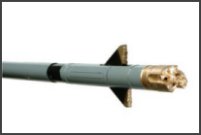 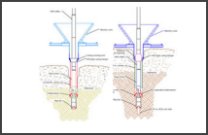
-
-
- In direct conflict with the 'Peak Oil' myth, the under-reamer
shown in these photos can restore an oil well's original production rate,
using basically the same principle as changing the oil filter in your
automobile engine
-
- Now we come to the completely false [or deliberately
misleading] claim by Peak Oil shills that production from existing oil
wells is "slowing down", thereby proving that the oil fields
are "running dry". This is so wrong that it is almost breathtaking.
Think of this slowing down process in the same way you might think of
the engine oil in your automobile. The longer you run the engine, the
higher the level of contaminates that get into the oil. The higher the
level of contaminates, the higher the level of friction. Sooner or later
you have something closely akin to glue coating your piston rings, and
the performance of your engine declines accordingly. This is an inevitable
mechanical process well known to all automobile owners.
-
- Henry Ford and others managed to slow down the rate of
contamination in engine oils by inventing the oil filter, through which
the oil has to circulate each time it passes around inside the engine.
A high percentage of the contaminates stick to the filter element, thereby
allowing extra miles between oil changes, though heaven help the careless
motorist who thinks he can get away without ever changing his clogged
oil filter when recommended.
-
- When oil is extracted from a producing formation underground,
it flows out through pores in the reservoir rock, and then into the open
borehole, from where it is transported to surface by the production tubing
string. So by the very nature of the beast, the bottom section of the
well is "open hole" which allows the oil to flow out in the
first place, but because it is comprised of exposed and sometimes unstable
rock, this open hole section is also continually subject to all manner
of turbulence and various contaminates. For example, tiny quantities of
super fine silt may exit through the pores but not continue to the surface
with the oil, tumbling around in the turbulence instead, until the silt
very slowly starts to block off the oil-producing pore throats. Yes,
of course there are a variety of liners that can be used to slow down
the contamination, but there is no such thing as a Henry Ford oil filter
10,000 feet underground.
-
- The inevitable result of this is that over time, the
initial production rate of the well will slowly decline, a hard fact
known to every exploration oilman in the business. However, this is certainly
not an indication that the oil field itself is becoming depleted, proved
thousands of times by offset wells drilled later into the same reservoir.
Any new well comes on stream at the original production rate of its older
cousins, because it has not yet had time to build up a thin layer of contaminates
across the open hole. Though as we shall see it is possible to "do
an oil change" on a producing well and bring it back to full production,
this is extremely expensive, and rarely used in the west.
-
- Look at a simple example: Say we have a small oil field
in Iraq with ten wells that each started out in life producing 10,000
barrels of oil per day. Fine, for a known investment we are producing
100,000 barrels of oil per day from our small field, at least for a while.
Five years later contamination may have slowed our overall production
down by ten percent to 90,000 barrels per day. So we are now faced with
a choice: either "do an oil change" on all ten existing wells
at vast expense and down time, or simply drill one additional well into
the same reservoir, thereby restoring our daily production to 100,000
barrels with the minimum of fuss. Take my word for it, ninety-nine percent
of onshore producers will simply drill the extra well.
-
- Naturally, there are times and places where this simple
process is not an option, for example on a huge and very expensive offshore
platform, which may have only 24 drilling 'slots', all of which have been
used up. To restore your overall production after five years you can
either build another giant platform next door for two billion dollars,
or "do an oil change" on each of your existing 24 wells, one
at a time. Clearly this time you are forced to carry out the time consuming
business of restoring the open hole section at the bottom of the well
to its old pristine condition, before various contaminates started to
slow down your production rate.
-
- For this task you first pull the production tubing out
of the hole, and then run back in with a drill string, to which is attached
an underreamer as shown in the pictures above. When the reamer is directly
opposite the top of the open hole producing section, the drill string
is rotated to the right and the blades fly out under centrifugal force
to a distance preset by you before lowering the tool into the hole. The
objective is to cut away the contaminated face of the well to a depth
you consider will once again expose pristine producing pores. As the spinning
underreamer is slowly lowered, it enlarges the size of the hole, with
the contaminated debris cut away and flushed back to surface by the drilling
fluid. Hey presto, you have a new oil well, and it only cost one or two
million dollars to restore
-
- Remember, I said this process is rarely used in the
west, which is true, but it is not true of Russia, where the objective
for many years has been to dominate global oil supply by continual investment.
With no shareholders holding out their grubby little hands for a wad of
pocket money every month, the Russian oil industry managed to surge ahead,
underreaming thousands of its older existing onshore wells in less than
ten years. Then along came Wall Street asset Mikhail Khodorkovsky, who
fraudulently got his hands on Yukos oil for a mere fraction of its value,
and was on the point of selling the entire outfit to the American multinationals
when Vladimir Putin had him hauled off his private jet somewhere in Siberia.
So Wall Street was finally 'cheated' of its very own 'free' Russian oil,
and poor old Mikhail had better get used to the taste of prison food.
-
- To recap, 'Peak Oil' claims that because today we only
find one barrel of oil for every four that we use, world oil reserves
are running out. Completely misleading propaganda. as the Russians [and
the CIA] know perfectly well, reserves of oil in the mantle of the earth
are infinite. 'Peak Oil' also claims that we will shortly be unable to
pump sufficient oil out of the ground to keep up with demand. Completely
misleading propaganda again. We could drill more wells, but Wall Street
cannot afford to pay for them, and never intended to, at least not while
it still believed conquest and eternal occupation of the Middle East was
a realistic possibility.
-
- Professor Poleo makes it quite clear which direction
the west needs to go in if it is to survive in the long term, and that
is to follow Russia's example by sharply reducing domestic consumption.
Back in 1990 America was using around 6 million barrels per day compared
to Russia's 8.4 million, but how things have changed since then. Thirteen
years later in 2003, American consumption was up to 9 million, while Russian
consumption had been reduced to a mere 3.2 million. A few billion folk
over there in America might like to walk around their houses and switch
off any electrical appliances they don't actually need. Believe me, I
can almost hear the oil surging through the pipelines in New York, and
I live more than 12,000 miles away in Australia.
-
- In closing, I would like to pass on my greetings and
thanks to the cheerful Russian drillers and scientists I had the pleasure
of working with at Bodra #3 in West Bengal, without whose expertise we
might all be dead today, as a direct consequence of repeated American
sabotage attempts on the high pressure well. My thanks also to the Moscow
Drilling Institute for the unrestricted flow of information and documents
on ultra deep oil production technology, without which I could not have
written this report.
-
- http://www.vialls.com/wecontrolamerica/peakoil.html
|